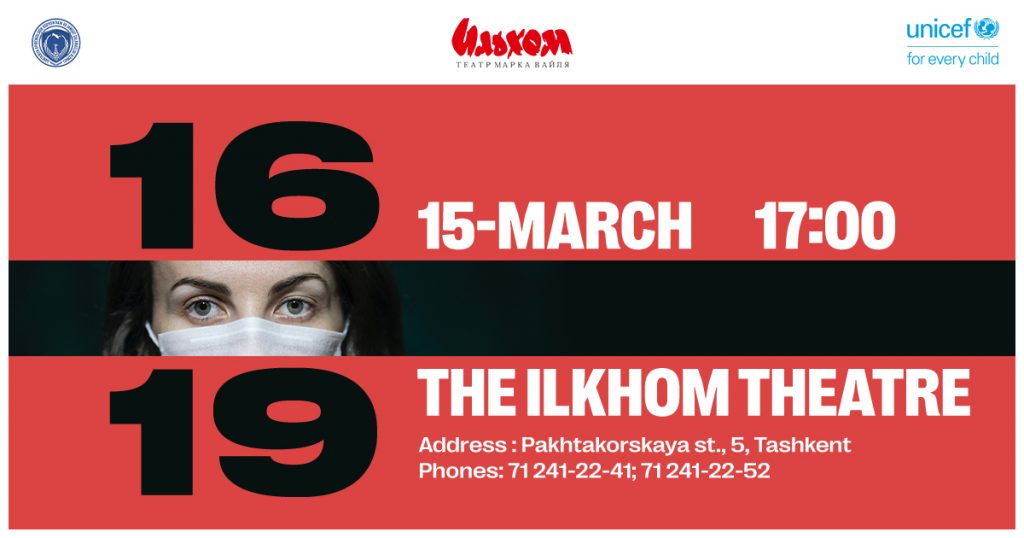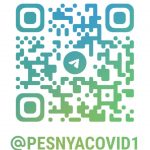
«16/19»
The COVID-19 pandemic has become a threat to human life on a global level. An extreme situation like this does not merely disrupt the usual routine of society; it also changes peopleŌĆÖs attitudes and behaviour.
Art always reflects reality. Sixteen artists in Uzbekistan were inspired by research undertaken at the Centre for the Study of the Sciences and Humanities of the University of Bergen in Norway. The study identified 16 personality types that have emerged in response to the COVID-19 pandemic. This categorization can refine forecasts of COVID-19 transmission and impact.
COVID-19 personality types:
1. Deniers: who downplay the viral threat, promoting business as usual.
2. Spreaders: who want it to spread, herd immunity to develop, and normality to return.
3. Harmers: who try to harm others by, for example, spitting or coughing at them.
4. Realists: who recognize the reality of the potential harm and adjust their behaviors.
5. Worriers: who stay informed and safe to manage their uncertainty and fear.
6. Contemplators: who isolate and reflect on life and the world.
7. Hoarders: who panic-buy and hoard products to quell their insecurity.
8. Invincibles: often young, who believe themselves to be immune.
9. Rebels: who defiantly ignore social rules restricting their individual freedoms.
10. Blamers: who vent their fears and frustrations onto others.
11. Exploiters: who exploit the situation for power, profit, or brutality.
12. Innovators: who design or re-purpose resources to fight the pandemic.
13. Supporters: who show their solidarity in support of others.
14. Altruists: who help the vulnerable, elderly, and isolated.
15. Warriors: who, like the front-line health care workers, combat its grim reality.
16. Veterans: who experienced SARS or MERS and willingly comply with restrictions.
To forecast viral transmission within populations accounting for different responses, these identified viral behaviors can be clustered by their ŌĆ£complianceŌĆØ efforts.
1. Non-compilers are individuals who fall into the following categories: Deniers, Harmers, Invincibles, and Rebels.
2. Partial compliers would be individuals who fall into the categories of: Spreaders, Blamers, and Exploiters.
3. Compliers would be individuals who are in the categories of Realists, Worriers, Contemplators, Hoarders, Innovators, Supporters, Altruists, Warriors, and Veterans.
The predominance of certain groups in the society will determine the transmission rate of the infection. Understanding which identity is most represented in the country will allow the authorities to build more effective tailored communication.
Through art, the artists showed their vision of people’s attitudes towards and ways of coping with the COVID-19 pandemic. This is how the name of the 16/19 exhibition came to be. The works of art also express hope for a quick return to normal life.
We believe that every viewer at the 16/19 exhibition will be able to recognize in the exhibits their own emotions and feelings brought about by life during the pandemic.
The project is implemented by the Ilkhom Theatre in cooperation with the Service of Sanitary and Epidemiological Welfare and Public Health of the Republic of Uzbekistan and with technical support of the United Nations Children’s Fund (UNICEF).
Project curators: Shakhnoza Karimbabaeva, Natalya Li, Irina Bharat

1. Avaz Abduraimov
Warriors, Rebels
The warriors are physicians fighting danger, fighting COVID-19, fighting for human lives.
The rebels, who do not believe in the existence of the coronavirus or the need for vaccination, defiantly disregard the safety rules that restrict their freedom.
2. Rushana Alimova
Hoarders
The accumulators may not see the line when the necessary grows into the excessive and the burdening. ŌĆ£Everything is poison. Everything is medicine. The dose determines which.ŌĆØ
3. Valeria Bataeva
Deniers
Every person in this world is part of a larger puzzle. Any choice we make becomes a piece of the big picture. We cannot change what happened. But we can choose where to go next.
4. Jama Adilov
Realists
The Pandemic Maze
We are all wandering in an invisible maze where an unfamiliar evil can be lurking in any corner. Sometimes this maze gets explored, and the evil turns out to be not as harmful as it is feared to be: it simply exists. And, if you are lucky, you can pass it by and avoid contacting it in this tangled maze of life. If you are luckyŌĆ”
5. Elena Voropaeva
Worriers, Hoarders, Supporters
Many people have felt like ‘caged birds’ during the pandemic.
Rodents symbolize people who buy non-perishable products in bulk, trying to protect themselves in the long run, but are still tormented by anxiety.
Many people found their strength during this period with the comfort of animals. Thanks to their little friends, people felt calmer and more stress-resistant during these unsettling times.
6. Zaza Zahidov
Veterans
The idea of the composition is to give the viewer an experience similar to that of being in critical danger. Perception of the environment and one’s own body at such a moment is greatly distorted: the horizon looms closer; the body becomes rigid and unable to move; the deep breaths whose sound fills the head are not sufficient for oxygen to be absorbed; and, a heartbeat speeding up to a dangerous frequency is clearly heard over the breathing.
Each element of the composition is made using a neural network. The elements are visualizations of the body, the lungs, the nervous system, sound, and breathing.
7. Zilola Kakhramonova
Contemplators
The project aims to show the process of transformation that everyone has gone through during the period of self-isolation. This transformation is both external and internal. Some people went through it consciously, some did not. Some people reflected on and changed their lives, and some just watched what was happening around them.
The artwork consists of a visual part that animates in the form of various images the sensations of external changes displayed by symbols, and an audio part that drives the listener into a certain state of discomfort accompanying any transformation.
8. Mohira Mullyajanova
Supporters
Two videos:
Name of the project: Untitled #1
Credits:
artist: Zi Kakhramonova
DOP: Alexey and Marina Nesterenko
Editor: Mohira Mullyadjanova
Music: ┬½Sha Gen ąĖ Firdavs Isoev-Happy Drum┬╗ An artist covers a black canvas with white paint. The black canvas symbolizes a world unstable, full of chaos and absurdity. The white paint symbolizes goodness and hope for the world. The artist in this video represents all creative people who, through their creativity, give the world hope.
Name of the project: Untitled #2
Credits:
dancer: Margarita Domakhina
DOP: Alexey and Marina Nesterenko
Editor: Mohira Mullyadjanova
Gaffer: Lev Lesin
Music: «Arlaeem Goovajdi-Lola Gullar»
Location: The Ilkhom theatre of Mark Weil
A dancer spins on a stage, performing her dance. As she spins, she covers the dark stage with a white cloth. The white fabric symbolizes goodness and promise for the world. The dancer in this video represents all creative people who, through their imagination, encourage us to keep moving in positive directions.
9. Munisa Isroilova
Harmers, Invincibles
Project concept
Project 1
There are two semi-circular shapes representing the division of the world and opinions during the pandemic. The idea is based on map sketches from the Middle Ages, which is supposed to suggest that, faced with a global problem, humankind has taken an enormous step back in time. The purpose of the project is to call for people to unite to rectify the situation.
Project 2
The picture in the form of a prism, symbolizing a distorted perception of the EarthŌĆÖs globe, depicts a map of the modern world. Various vertical and diagonal lines represent the many different ways the present situation is approached in different regions. Despite the use of map layouts, there is no point in bringing up politics other than the politics of humanity.
10. Leyla Rakhmatullaeva
Realists, Veterans
Breathing
The panic of not being able to take a full breath, especially familiar to people who have been sick with COVID-19. In this state, the lungs are especially sensitive, as if they are only made up of tiny holes.
Involvement
People during the lockdown, locked up in their houses, are masks of faces peering out of windows. They are both close to and far from each other at the same time.
This is observation. Expectation. Involvement.
QR codes of channels with the music:
https://t.me/+QcGx82aDAJM1Y2Ji
https://t.me/+5oP0k9pWGDczNmZi


11. Seviliya Akramova
Spreaders, Blamers, Exploiters
The Faces series of posters.
1. The weeping mask.
A weeping mask of humankind that is still recovering from the wounds of the fight against an invisible enemy. A desiccated tree is a symbol of loss and sorrow, but also of awakening and return of life.
2. The vanity mask.
A mask with a smirk is in front of a mountain of heads of those who have lost their dreams and heartbeats. It is a terrible smirk, a smirk of indifference.
There is also a dry tree here ŌĆō our home and our protection.
3. The scream mask.
Like the dry branches of a tree, terrible thoughts of the pandemic horrors work through our heads. The tree makes us think about the effect of a human life, how it affects nature, and all our illnesses and hardships. We ourselves have to improve the situation and preserve a fragile world.
12. Eldos Fazylbekov
Contemplators
They isolate themselves as much as possible and dispassionately observe the situation. They are also self-isolated. They are all among us, but at the same time not with us. They are always watching us closely. Sculptures are contemplators.
13. Nafisa Khusnitdinova
Harmers, Veterans, Worriers
1. A harmer is a person whose intentions have become dishonourable, who clearly rejects everything around them, negatively impacting others.
2. Veterans. The lungs made of books mean that the person has a lot of knowledge and experience of similar situations. The iris implies wisdom and understanding, and the flower symbolizes the personŌĆÖs inner spiritual core.
3. Worriers. These fragile flowers have completely closed in on themselves because of the situation with COVID-19. They are wary of everyone and everything, and fear that everyone around them is infected; this feeling of fear and anxiety never leaves them.
14. Edie Yagly
Invincibles, Innovators
Work title: Transformation
The idea is to convey the image of a new person. The QR code transforms human consciousness and vision of the world, creating an aura of invincibility. The QR code is a kind of ŌĆ£boarding ticket to the futureŌĆØ. The monochromatic rendering of the composition presents a division of life into before and after the beginning of the new Era of QR. Today the code opens all doors. The main concept is the creation of a “portal” that everyone needs to pass through in order to get into this new world.
15. inkuzart
Realists
The Coronavirus Symphony No. 19
16. Arlaeem Goovajdi
Rebels, Partial rebels, Supporters
ŌĆówho am I ?.
musical journey into yourself
Composer Arlaeem Goovajdi
musical collaborator: Le Luu Lien
Arlaeem Goovajdi : musician, performing, art-artist, Ilkhomlover
Mirror 1
https://t.me/pesnyacovid1
Mirror 2
https://t.me/pesnyacovid2
Mirror 3
https://t.me/pesnyacovid3
Mirror 4
https://t.me/pesnyacovid4









